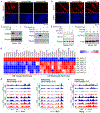Histone demethylase KDM6A directly senses oxygen to control chromatin and cell fate
- PMID: 30872525
- PMCID: PMC7336390
- DOI: 10.1126/science.aaw1026
Histone demethylase KDM6A directly senses oxygen to control chromatin and cell fate
Abstract
Oxygen sensing is central to metazoan biology and has implications for human disease. Mammalian cells express multiple oxygen-dependent enzymes called 2-oxoglutarate (OG)-dependent dioxygenases (2-OGDDs), but they vary in their oxygen affinities and hence their ability to sense oxygen. The 2-OGDD histone demethylases control histone methylation. Hypoxia increases histone methylation, but whether this reflects direct effects on histone demethylases or indirect effects caused by the hypoxic induction of the HIF (hypoxia-inducible factor) transcription factor or the 2-OG antagonist 2-hydroxyglutarate (2-HG) is unclear. Here, we report that hypoxia promotes histone methylation in a HIF- and 2-HG-independent manner. We found that the H3K27 histone demethylase KDM6A/UTX, but not its paralog KDM6B, is oxygen sensitive. KDM6A loss, like hypoxia, prevented H3K27 demethylation and blocked cellular differentiation. Restoring H3K27 methylation homeostasis in hypoxic cells reversed these effects. Thus, oxygen directly affects chromatin regulators to control cell fate.
Copyright © 2019 The Authors, some rights reserved; exclusive licensee American Association for the Advancement of Science. No claim to original U.S. Government Works.
Figures



Comment in
-
Histone modifiers are oxygen sensors.Science. 2019 Mar 15;363(6432):1148-1149. doi: 10.1126/science.aaw8373. Science. 2019. PMID: 30872506 No abstract available.
-
Hypoxia makes its mark on histones.Nat Rev Mol Cell Biol. 2019 Jun;20(6):324-325. doi: 10.1038/s41580-019-0122-6. Nat Rev Mol Cell Biol. 2019. PMID: 30918336 No abstract available.
References
-
- Kaelin WG Jr., The von Hippel-Lindau tumour suppressor protein: O2 sensing and cancer. Nature reviews. Cancer 8, 865 (2008). - PubMed
-
- McDonough MA, Loenarz C, Chowdhury R, Clifton IJ, Schofield CJ, Structural studies on human 2-oxoglutarate dependent oxygenases. Current opinion in structural biology 20, 659 (2010). - PubMed
-
- Hancock RL, Dunne K, Walport LJ, Flashman E, Kawamura A, Epigenetic regulation by histone demethylases in hypoxia. Epigenomics 7, 791 (2015). - PubMed
Publication types
MeSH terms
Substances
Grants and funding
LinkOut - more resources
Full Text Sources
Other Literature Sources
Molecular Biology Databases
Research Materials
Miscellaneous

